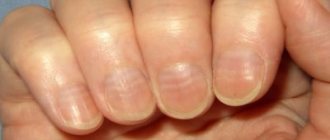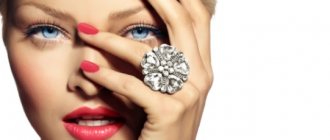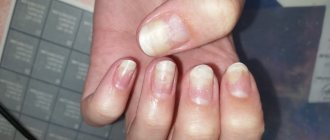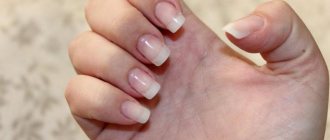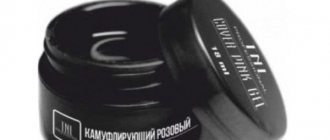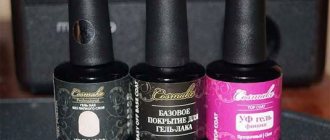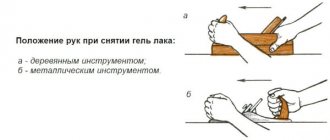Girls now often prefer a decorative coating to natural nails, since it always looks neat, hiding imperfections in the nail plate, which immediately transforms the manicure and makes it well-groomed.
However, not everyone knows that gel polish is a rather aggressive coating, so it must be used carefully, as there is a risk of problems with the nail bed. To do this, first pay attention to the quality of the composition used so that aggressive substances do not split the sensitive surface.
Causes
Onycholysis is damage to the natural nail plate, which is associated with the appearance of large detachments on the nail bed, which most often form on one finger or simultaneously on all.
Delaminations are usually accompanied by the appearance of pain when pressure is applied to the nail, as it becomes thinner and becomes more vulnerable.
If a girl has onycholysis after gel polish, why this happened is usually related to her careless handling of the pedicure or manicure area. However, problems with the internal state of the body can also provoke a defect, since organ dysfunction and lack of vitamins in the matrix reduce the integrity and density of the nail.
There are several reasons for the appearance of onycholysis:
- The use of low quality compounds when performing decorative gel polish coating. Even if you do the procedure in a salon, you first need to make sure that the specialist does not use aggressive solutions with acids or alkalis in the composition.
- Mechanical damage. In case of injury to a finger or the nail itself, there is a risk of formation of detachments; this is due to impaired blood circulation and the integrity of the location of the stratum corneum in the plate. Trauma can be of any kind - damage to bone tissue, pinching, bruise, splinter, burn.
- Fungal infection. It occurs quite often, and affects the condition of the entire nail bed.
- Allergic reaction. Even if the master used a high-quality gel or varnish in the salon, the girl may be allergic to any components of the composition, so it is important to make sure that there is no individual intolerance.
It is quite simple to independently find out the reason that triggered the defect, since most often it appears immediately after removing the decorative coating or mechanical injury to the finger.
If onycholysis did not appear due to gel polish, but due to a fungal infection, then the lesion is accompanied by other signs of symptoms that appear almost immediately: a change in the color of the nail, the appearance of dark or white spots or stripes, deformation of the bed, and its thinning. If the fungus appears on the feet, then the nails may grow into the side ridges.
However, not always when the quality of the gel or varnish is poor, a girl develops a large separation on her nail. It can be provoked by the state of health of the body:
- Diabetes;
- Lack of vitamins and microelements in the blood;
- Recent illness;
- An infectious disease accompanied by severe inflammatory processes;
- Hormonal disbalance;
- Circulatory disorders
- Long-term use of strong medications and antibiotics.
A decrease in general or local immunity often leads to problems with nails, since the fingertips contain nerve endings that connect the hands to all organs and systems. Because of this, any problems or dysfunctions are reflected in changes in the quality of the manicure.
Because of this, the reaction with gel polish may increase - onycholysis appears, which gradually increases, and the entire stratum corneum peels off.
Also keep in mind that a problem may arise with constant, continuous application of decorative coating. Nowadays, girls almost always use the services of a nail technician to apply gel polish, which strengthens the nail and ensures its neat appearance. However, this affects the lack of oxygen supplied to the stratum corneum, which reduces the regeneration of epithelial cells, metabolism, and gradually deteriorates the plate.
To prevent its delamination, it is recommended that every 3-5 times you perform a manicure, remove it completely and walk with natural nails until a healthy bed grows back. Typically this takes up to two months.
What is mold?
Mold is a fungal infection that causes the disease onychomycosis. About 15% of the population is infected with a fungus; most patients suffer from mold fungi or dermatophytes.
The infection affects the skin, scalp, and nail plates. There are a huge number of varieties of fungus, but in terms of symptoms and methods of treatment they have virtually no differences.
A characteristic feature of mold is the inability to penetrate into the deep layers of the epidermis and nails. With nail pathology, microorganisms spread from the inner edge to the outer edge. The disorder often develops in older people because their nails grow too slowly.
Mold does not make itself felt for a long time, for this reason it is considered an exclusively cosmetic problem, and the patient does not pay due attention to it.
Moreover, the older the fungus, the more difficult it is to get rid of it in the future; the symptoms become more pronounced.
How it manifests itself
It is standard that if any dermatological disease is detected, girls are advised to consult a doctor (surgeon, dermatologist or pathologist) to examine the affected area. However, onycholysis is quite easy to recognize, since the disease has several signs of symptoms that are characteristic only of it.
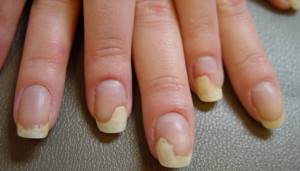
There are several symptoms:
- A detachment begins to form from the free edge, which gradually begins to increase;
- The marigold changes color, becoming gray. This is due to the presence of an air gap between the main bed, the exfoliated stratum corneum;
- Deformation of the nail appears, irregularities form on it - depressions and bumps, it becomes rough, matte, cloudy;
- The finger may smell unpleasant due to pathogenic bacteria getting under the detachment.
Keep in mind that a girl can detect these signs in the initial stages of development of damage after gel polish. However, if left untreated, pathogenic microflora can enter the damaged area, which leads to yellowing of the nail, the formation of ingrowths, dark spots on the surface, and pain.
Onycholysis can spread not only along the fingernails. Lack of treatment can also lead to the formation of dermatological defects, which affect the integrity of the epidermis, the appearance of irritation, inflammation, and small rashes.
There are two types of damage after gel polish, which determine the visual condition of the manicure:
- Partial. A layer appears, occupying about half of the nail, which makes it uneven, as it rises above the healthy area.
- Complete. It consists in the separation of the stratum corneum from the entire nail, then it becomes thinner and may break prematurely.
The disease usually does not cause pain, especially if only a small part is separated in the area of the free edge. However, when the surface is infected with pathogenic microorganisms, there is a risk of inflammatory processes, which can lead to discomfort.
Prevention methods
Due to the fact that Pseudomonas aeruginosa is resistant to a large number of disinfectants, disease prevention is somewhat more complicated.
- In public places, such as swimming pools or hotels, when interacting with water, it is best to have personal slippers with you.
- Do not walk barefoot on beaches, public baths and saunas.
- Do not use someone else's manicure tools or use someone else's towel.
- Use gloves when working in the garden.
- Shoes should be loose and made from natural materials.
Those who often spend time in public baths or swimming pools have a high risk of contracting Pseudomonas aeruginosa.
In such cases, you should pay attention to antifungal drugs for treating feet.
Fingernails and toenails infected with pseudomonia and “blooming” with greenery are not only an aesthetically unpleasant sight, but also pose a great danger to health. Do not delay treatment; consult a doctor on time to avoid additional complications.
Treatment
Regardless of the form of onycholysis that occurs after using gel polish and the degree of its spread over a healthy surface, treatment should begin immediately to prevent progression of the damage.
Recovery should always begin with a consultation with a doctor. You can contact one of three doctors:
- Surgeon;
- Dermatologist;
- Pathologist.
If you know that the cause of detachments is not gel polish, but a fungal infection, then you can immediately consult a mycologist.
When visiting the hospital, the girl’s manicure area is examined, and sometimes tests are prescribed to determine the degree of development of the disease and the presence of pathogenic microflora that provokes tissue inflammation. Based on the results of the tests, treatment is prescribed.
Since it is not recommended to apply gel polish during the recovery period, it is worth paying attention to complex therapy. It will help restore the structure of the manicure faster and you will return to visiting the nail service specialist.

Complex therapy usually consists of several treatment methods: using or taking medications, following traditional recipes and observing proper hand care.
If pathogenic bacteria have penetrated the plate, it is important to pay attention to the intake and application of antifungal agents:
- External - Lotseril, Lamisil, Exoderil, Mikozan.
- For oral administration – Pimafucin, Nystatin.
For initial and active forms of lesion development, only external medications are prescribed. To eliminate the advanced form, you first need to relieve the inflammatory processes, for which antimycotics are used.
The affected plate itself must be periodically trimmed or filed as the free edge grows. Also pay attention to its daily treatment with antiseptic agents to prevent the progression of onycholysis. Hydrogen peroxide or special alcohol-based products can be used as an antiseptic.
To speed up the recovery period for natural manicure, pay attention to increasing local immunity and accelerating metabolism. For this, one of the drugs is used - Panthenol or Bepanten.
It is additionally recommended to use folk recipes that will additionally care for the sensitive surface:
- Salt baths. To eliminate pathogenic microflora and restore the surface structure, dissolve 3 tablespoons of sea salt and 2 tablespoons of baking soda in a liter of water. Immerse your hands in the warm solution for 15 minutes, and then wipe dry with disposable paper towels without rinsing;
- Compress with onions. Finely chop the onion into a paste and strain, leaving only the juice. After this, mix aloe, onion and lemon juice in equal proportions. Soak gauze folded several times in the healing liquid and apply it to your finger, tightly fixing the compress with an adhesive plaster for half an hour;
- Treatment with iodine or lemon juice. Every day it is recommended to wipe the entire plate and cuticle area with iodine solution or freshly squeezed lemon juice to gradually restore the structure of the nail;
- Lotions with chicken protein. To do this, break the egg and separate the white, placing it in a narrow glass. Gradually pour in the alcohol, stirring thoroughly until white clots begin to form. After this, strain the liquid, soak a cotton pad in it and apply it to the nail until dry.
You need to use traditional recipes every day, since long breaks can reduce the effectiveness of natural manicure treatment, which is why the girl will have to use medications longer.
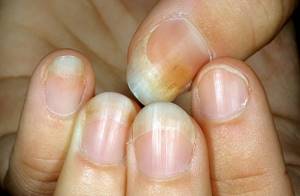
Additionally, during rehabilitation, the girl is prescribed recommendations for hand care, which include preventing relapse. You should also follow the advice as a preventive measure after finishing treatment:
- When treating nails, first disinfect the tools you use and use them carefully without damaging the skin.
- When performing household work for which you use chemicals containing aggressive components, wear protective rubber gloves.
- Before applying gel polish, make sure there is no allergic reaction to it. To do this, you first need to distribute it over one nail and leave it for a day.
- When working with metal and wood, use thick protective gloves to prevent the introduction of splinters.
- If there is mechanical damage to your fingers or hands, treat the area with hydrogen peroxide and apply a sterile bandage to prevent infection from entering the open wound.
It is recommended to apply essential oil to the cuticle every day before bed and massage it in. This way you will speed up the metabolism in tissues and increase the local immunity of your fingers.
Diagnostics
First of all, the doctor carefully examines the nails on the hand, or rather the white voids, but a visual examination does not allow one to correctly differentiate the diagnosis. It is possible that an infection got inside, or the destructive effect of the fungus began with the tip of one finger, but will soon spread to the entire hand. To make an accurate diagnosis, the doctor carefully cuts off part of the pathology focus, and then examines it under a microscope to identify the specific features of the pathogenic flora. After this, the patient may be prescribed medications for topical use and oral administration.
Results
To get rid of the emptiness under your toenails and fingernails as quickly as possible, you just need to follow all the prescriptions of your doctor, who has already cured dozens of people from onycholysis. In order to prevent the fungus from developing subsequently, it is necessary to constantly monitor the condition of the nails and do a pedicure. After all, the skin, dirt, and tissues that accumulate under the nails can give such an effect. It is also worth protecting yourself from contact with chemicals and detergents using rubber gloves. This will help maintain the softness of the skin and its healthy color. Onycholysis on the legs is identical to what occurs on the arms.
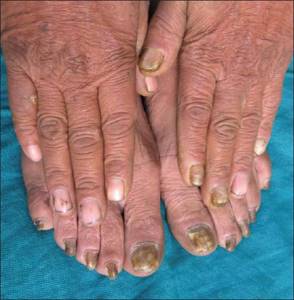
Girls should not constantly cover their nails with varnish so that they can breathe. If a person is affected by a disease such as onycholysis, photos taken before and after treatment will be very different to the naked eye. In addition, strengthening the entire body will be a good preventative measure. Sports activities, contrast showers, jogging, fruits and vegetables are suitable for this.
It is possible to protect yourself from emptiness under your toenails and fingernails. To do this, you should have the necessary information and follow recommendations for maintaining your health. It should be noted that with a disease such as onycholysis, it makes sense to take photos of the affected nails in order to be able to evaluate the results of treatment.
You need to take care of your nails
Emptiness under the nails can begin with such harbingers of the disease as dots, spots, stripes. So if there are such traces, it’s worth thinking about starting treatment or prevention.
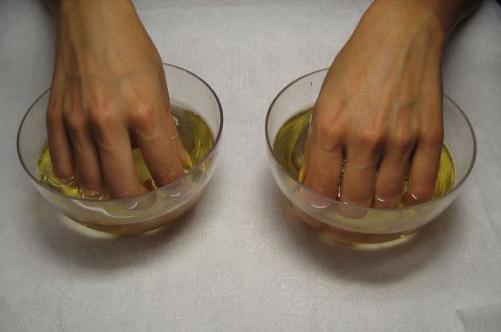
It will take a lot of time and effort to get rid of the disease. This is due to the fact that it is necessary to cure not only the nails, but also the entire body. Even in order to strengthen the immune system, if someone does not want to believe in the nail diagnostic method. Stomach, heart, nerves, skin, vascular system - all these organs and systems can affect not only a person’s condition, but also his nails.

